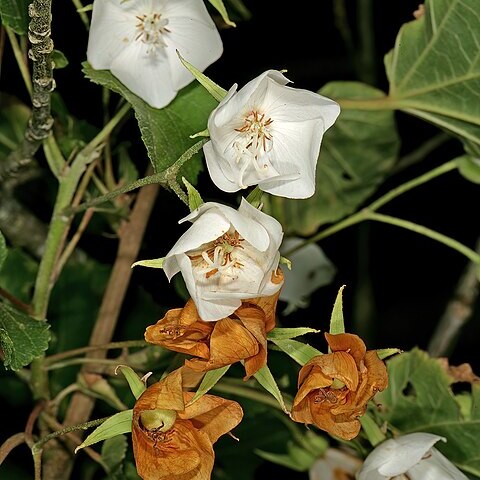Shrub, sometimes straggling, 2-3 m high or tree up to 10 m tall. Branchlets slender, longitudinally ridged, with prominent leaf-scars and with small, pale, raised lenticels, glabrescent but new growth laxly to densely stellate-pubescent with patent or appressed hairs rarely up to 1 mm long. Stipules early caducous, linear-subulate from a rather broad base, (rarely deltoid to narrowly deltoid-long-acuminate), sparsely to densely stellate-pubescent, glabrescent, sometimes subpetaloid. Leaves often thin in texture, ovate, gradually acuminate, sometimes 3-lobed at the apex, the 2 lateral lobes shallow, 3-10 cm long, 2-8 cm broad, shallowly to deeply cordate, rarely rounded or subtruncate at the base, margins crenate to crenate-dentate, the lateral veins running to the point of the tooth but not clearly excurrent, nerves from the base 3-7 but usually 5, upper and lower surfaces thinly to densely stellate-pubescent, often glabrescent, hairs sometimes longer and some simple on the lower surface; petiole 2-6.5 cm long, usually subspreading, stellate-pubescent and with simple spreading hairs, usually under 1 mm long, glabrescent. Inflorescence cymose to subumbellate, usually appearing in late summer or autumn in the axils of the upper leaves, 2-9-flowered; peduncle usually straight, 1.5-8 cm long, stellate-pubescent and sometimes with simple hairs as well, hairs usually under 1 mm long; pedicels 1.5-3 cm long, pubescent like the peduncle. Buds ovate or spindle-shaped. Bracts 3, free, early caducous, variable in size and shape from broadly ovate to narrowly linear, 5.5-10 mm long, 1-4 mm broad, gradually and shortly acuminate at the apex or abruptly acuminate into a caudate apical third, margins sometimes with an odd lobe or two, shortly stellate-pubescent on both surfaces, the broad bracts usually close to the rounded base of the calyx and the narrower ones at the base of the stipe. Calyx lobed almost to the base, united portion 2.5 mm long, rounded at the base or with a short or long stipe, up to 4 mm long; lobes usually reflexed, narrowly oblong-acuminate, about 9-15 mm long, 2.5-4 mm broad, pubescent dorsally. Petals persistent, white (rarely pink) turning rust-coloured with age, oblique, cuneate, about 12-17 mm long, 11-16 mm broad at the apex. Stamens united at the base into a tube 2-4.5 mm long; filaments of different lengths, the longest about 4 mm long; anthers 2-3.5 mm long; staminodes about 11 mm long. Ovary tomentose and with a few projecting hairs in the apical portion, but these hairs usually under 1 mm long, 5-celled but sometimes imperfectly so; ovules 2-4 per cell; style 8-10 mm long, 2-5-branched at the apex, glabrous or stellate-pubescent in lower half. Capsule about 7 mm long, stellate-tomentose, hairy on the sutures within; seed 3sided and broadly rounded at the top, about 5 x 7 mm, rough, with minute ridges and dots.
More
Straggling shrub or tree, 2.0-9.1 m high. Stipules early deciduous. Leaves thin-textured, ovate, gradually acuminate, sometimes 3-lobed, shallowly cordate at base, margins crenate-dentate, 3-7-nerved from base; thinly stellate-pubescent on both surfaces. Inflorescences cymose, appearing in autumn, 2-9-flowered, in axils of upper leaves; peduncles straight 15-80 mm long; pedicels stellate-pubescent. Flowers 12-17 mm long, white, aging rusty brown. Sepals with lobes 9-15 mm long, pubescent on outside. Petals persistent. Flowering time Aug.-May. Fruit a capsule, ± 7 mm long, stellate-tomentose. Seed solitary, 3-sided, rough.


